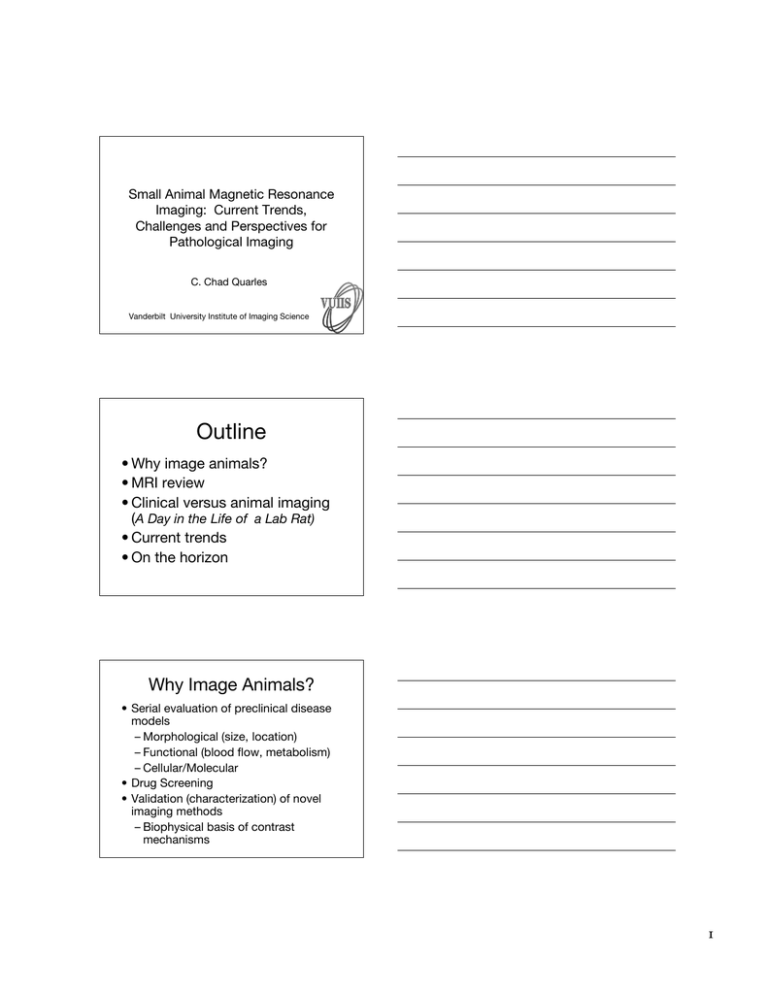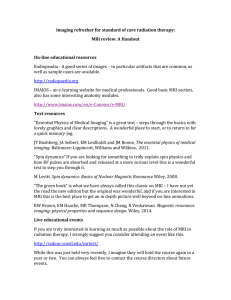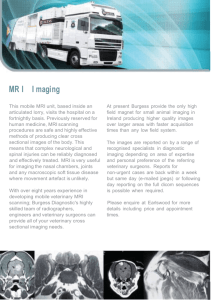Document 14260756
advertisement

Small Animal Magnetic Resonance Imaging: Current Trends, Challenges and Perspectives for Pathological Imaging C. Chad Quarles Vanderbilt University Institute of Imaging Science Outline • Why image animals? • MRI review • Clinical versus animal imaging (A Day in the Life of a Lab Rat) • Current trends • On the horizon Why Image Animals? • Serial evaluation of preclinical disease models – Morphological (size, location) – Functional (blood flow, metabolism) – Cellular/Molecular • Drug Screening • Validation (characterization) of novel imaging methods – Biophysical basis of contrast mechanisms 1 Why Use MRI? Technique Resolution Depth Time Cost Uses (animals) MRI 10-100 µm No limit MinHrs $$$ High contrast, physiology, cell tracking CT 50 µm No limit Min $$ Lung/Bone tumor Imaging No limit Min $$$$$ Metabolism of molecules/probes PET/SPECT 1 - 2 mm Ultrasound 50 µm mm Min $$ Vascular, Gross Morphology Optical 1 - 2 mm cm SecMin $$ Molecular, gene expression Source: R.Weissleder, Nature Reviews Cancer, Vol 2, Jan 2002 Bioluminescence MicroCT Fluorescence Cancer Imaging at VUIIS Doppler US MRI MRA MCES MicroPET and MicroSPECT Imaging Across Scales 1) tumor size 2) tumor morphology anatomical/physiological 3) vascularity 4) cell proliferation 5) cell density cellular 6) apoptosis 7) cell surface receptors 8) extracellular milieu molecular 2 MRI Review Basis of NMR N S Hydrogen nuclei are small magnets Normally they point in all different directions MRI Review MRI Disturb with RF energy Magnetization Precession Relaxation to Equilibrium Localization 3 Transverse and Longitudinal Magnetization B0 Z Net Magnetization Longitudinal Magnetization: MZ Transverse Magnetization: MT Y X T1 T2 Relaxation Contrast Different tissues have different T1 and T2 values T1 Contrast T2 Contrast Different weighting, different contrast T1 Proton T2 4 Other Ways to Generate Contrast • • • • • Alter T1 and T2 with paramagnetic contrast agents – – Non-Targeted (permeability, blood flow) Targeted (cellular and molecular imaging) Diffusion weighting Flow contrast Susceptibility weighting ... Clinical vs. Animal MRI SNR • Resolution (↑Resolution ↓SNR) – Human ~ 100 kg: 10 mm3 (1 x 1 x 10 mm) – Rat ~ 300 g: .03 mm3 ( 310 x 310 x 310 µm) – Mouse ~ 25g: .0025 mm3 (165 x 165 x 165 µm) • Imaging time – To maintain SNR: t α 1 / x6 • Magnetic field strength (↑T ↑SNR) – Clinical (1.5T - 3T) – Animal (1.5T - 11.7T) • RF coil (↓Size, better coupling, ↑SNR) Reviews: GA Johnson, JMRI 16 (2002) Clinical vs. Animal MRI (2) Practical Aspects (or my soap box) • Commercially available animal MRI systems come with very basic software packages • Typically poor QC and QA • Necessitates a dedicated MRI physicist/programmer/engineer for pulse programming, software debugging and hardware development. (need a job?) VUIIS: 2 MRI physicists and 1 engineer for 4 dedicated animal MRI systems • Hardware -- clinic to lab 5 Data Issues • Processing/Storing threedimensional volumetric datasets (multi-modal and multi-parametric) is challenging. – 1 animal / 1 session ~ 1 - 5 GB • Quantitative metrics, image fusion • Screening, High throughput studies? • Automation Animal Handling Day 0: Animals Delivered Days 1-7: Animal acclimation Day 8: Tumor Inoculation Day 13: Catheters implanted Days 14-35: Imaging Studies Days 14-35: Treatment Application Imaging Issues (2) • Tune/Matching • Shimming • Respiratory / Cardiac Gating • Human RR ~ 20 breaths / minute • Mouse RR ~ 160 breaths / minute • Human HR ~ 72 beats / minute • Mouse HR ~ 632 beats / minute 6 Outline • Why image animals? • MRI review • Clinical versus animal imaging (A Day in the Life of a Lab Rat) • Current trends • On the horizon Current Trends 1) tumor size 2) tumor morphology 3) vascularity anatomical/physiological DCE-MRI, BOLD-MRI, ASL, 4) cell proliferation 5) cell density 6) apoptosis 7) cell surface receptors 8) extracellular milieu cellular Diffusion, Spectroscopy molecular Anatomical Localization/Size Untreated • Rat glioma model • Anti-angiogenic therapy • T1 -Weighted Images after Gd-DTPA injection Treated C. Quarles, Magn Res Med 2007 7 Vascular Properties: DCE / DSC MRI Interaction Direct (T1) Field (T2,T2*) • Increase MRI Signal • Decrease MRI Signal • Dynamic Contrast Enhanced (DCE) MRI • Dynamic Susceptibility Contrast (DSC) MRI DCE-MRI: Physiological Parameters Physiological parameters that influence the temporal distribution of this contrast agent blood volume: BV (units: ml · g-1) extravascular extracellular (EES) volume fraction: v e vascular permeability: P·S (units: ml · g-1 · min-1) blood flow: F (units: ml · g-1 · min-1) Quantitative Analysis Using a Compartmental Model Knowns: Cp , C t Capillary (vp) EES (ve) Cp Ktrans Unknowns: Ktrans, ve Ce Note: Ct Ktrans related to F and PS 8 DCE MRI Examples (1) T.E. Yankeelov, VUIIS DCE MRI Example (2) C. Quarles, Magn Res Med 2008 (in press) DSC-MRI: Physiological Parameters Physiological parameters that influence the temporal distribution of this contrast agent blood volume: BV (units: ml · g-1) blood flow: F (units: ml · g-1 · min-1) transit times (sec) 9 DSC MRI: Preclinical Studies CBF CBV MTT Control Treated C. Quarles, Magn Res Med 2007 BOLD MRI • Blood oxygen level-dependent MRI • MRI signal intensity reflects oxygenation status of hemoglobin • dHb - Fe2+ is in a paramagnetic high spin state • Alters R2* (1/T2*) transverse relaxation rates of water in blood and in the tissue surrounding the blood vessels • Potentially useful for predicting response to oxygen enhancing therapeutics (e.g. changes in hypoxic fraction or responsiveness to radiation treatment) BOLD MRI • Compared BOLD and radiation response in GH3 and RIF-1 tumor models while animals breathed air or carbogen GH3 RIF-1 L.M. Rodrigues, JMRI 2004 10 Validation of CR-BOLD Contrast Arterial Spin Labeling Used to quantify tissue perfusion 1. Acquire a “control image” 2. Tag Inflowing blood using selective RF pulse 3. Acquire the “tag image” ∝ CBF Image source: http://www.umich.edu/~fmri/asl.html Rodent ASL Issues • Human studies typically employ a single coil for labeling and imaging • Difficult in rats/mice because labeling and imaging plane are in close proximity – RF irradiation for labeling can saturate the magnetization of macromolecules within the imaging plane (magnetization transfer) – Results in loss of water signal intensity Detection Coil Labeling Coil Labeling Plane 11 Biological Study B. Moffat, Clinical Cancer Research, 2006 Current Trends 1) tumor size 2) tumor morphology 3) vascularity anatomical/physiological DCE-MRI, BOLD-MRI, ASL, 4) cell proliferation 5) cell density 6) apoptosis 7) cell surface receptors 8) extracellular milieu cellular Diffusion, Spectroscopy molecular Diffusion B. Ross, Mol Can Ther, 2003 12 T2 ADC B. Ross, Mol Can Ther, 2003 Spectroscopy • Non-invasive assessment of tissue specific metabolites • Lactate - evidence of increased glycolysis • Choline - shown to be useful for malignant diagnosis, treatment planning and monitoring treatment response Spectroscopy Matsumoto, J Clin Invest, 2008 13 Spectroscopy Hot Topics • Sodium Imaging • pH Imaging • Cell Tracking • Molecular Imaging 23Na MR Imaging • Cell division and the acidic extracellular microenvironment of tumors cells are associated with an increase in intracellular 23Na concentration. VD Schepkin, NMR in Medicine, 2006 14 23Na MR Imaging • Cell division and the acidic extracellular microenvironment of tumors cells are associated with an ADC in intracellular 23Na increase concentration. Na VD Schepkin, NMR in Medicine, 2006 pH Imaging • Development of pH sensitive MRI contrast agents is a highly active area of research. • Two strategies – Act as a T1 agent (Gd-based) – Directly image the agent using spectroscopy pH Imaging • Development of pH sensitive MRI contrast agents is a highly active area of research. • Two strategies – Act as a T1 agent (Gd-based) – Directly image the agent using spectroscopy ML Garcia-Martin, Cancer Research, 2001 15 pH Imaging • Development of pH sensitive MRI contrast agentsPermeability is a highly active area Vascular Volume Fused of research. • Two strategies – Act as a T1 agent (Gd-based) – Directly image the agent using spectroscopy Fused + pH Z. Bhujwalla, NMR in Biomedicine, 2002 Cell Tracking (1) • Bone marrow derived neural precursor cells incorporate into growing tumor vessels. • Can be labeled with MRI-visible iron oxide nanoparticles and injected systemically • Study - Image 10 days after injection of labeled cells S. Anderson, Blood 2005 Cell Tracking (1) • Bone marrow derived neural precursor cells incorporate into growing tumor vessels. • Can be labeled with MRI-visible iron oxide nanoparticles and injected systemically • Study - Image 10 days after injection of labeled cells S. Anderson, Blood 2005 16 Cell Tracking (2) • Neural precursor cells also colocalize within Multiple Sclerosis lesions. • Can be labeled with MRI-visible iron oxide nanoparticles and injected systemically • Study - Image 24 hours after injection of labeled cells L. Poloti, Stem Cells 2007 Cell Tracking (2) • Neural precursor cells also colocalize within Multiple Sclerosis lesions. • Can be labeled with MRI-visible iron oxide nanoparticles and injected systemically • Study - Image 24 hours after injection of labeled cells L. Poloti, Stem Cells 2007 ανβ3 Integrin Imaging • Angiogenesis depends on adhesive interactions of endothelial cells • ανβ3 is an important adhesion receptor integrin and has been imaged by many modalities • Study: Compared non-targeted and targeted Gd-loaded liposomes DA Sipkins, Nature Medicine, 1998 17 ανβ3 Integrin Imaging • Angiogenesis depends on adhesive interactions of endothelial cells • ανβ3 is an important adhesion receptor integrin and has been imaged by many modalities • Study: Compared non-targeted and targeted Gd-loaded liposomes DA Sipkins, Nature Medicine, 1998 Her-2/neu Imaging • The HER-2/neu receptor is an important target for tumor prognosis and therapy. • It is overexpressed in approximately 25% of human breast cancers • HER-2/neu expression correlates with poor prognosis for breast and other forms of human cancer. D. Artemov, Cancer Research 2003 Her-2/neu Imaging • The HER-2/neu receptor is an important target for tumor prognosis and therapy. • It is overexpressed in approximately 25% of human breast cancers • HER-2/neu expression correlates with poor prognosis for breast and other forms of human cancer. D. Artemov, Cancer Research 2003 18 Her-2/neu Imaging • The HER-2/neu receptor is an important target for tumor prognosis and therapy. • It is overexpressed in approximately 25% of human breast cancers • HER-2/neu expression correlates with poor prognosis for breast and other forms of human cancer. D. Artemov, Cancer Research 2003 Her-2/neu Imaging • The HER-2/neu receptor is an important target for tumor prognosis and therapy. • It is overexpressed in approximately 25% of human breast cancers • HER-2/neu expression correlates with poor prognosis for breast and other forms of human cancer. D. Artemov, Cancer Research 2003 Conclusions • Animal MRI Advantages: High contrast, sensitive to many physiological and biochemical tissue characteristics • Animal MRI Disadvantages: Costly, time consuming, requires substantial infrastructure • Derived metrics useful for disease characterization, treatment planning and monitoring • Serves as a screening process for clinically relevant tools 19 Acknowledgements • • • • • Tom Yankeelov Mark Does*** Chris Wargo Daniel Colvi Noor Tantaway *** Hates that I exported his fancy and neat Keynote slides into Powerpoint 20






